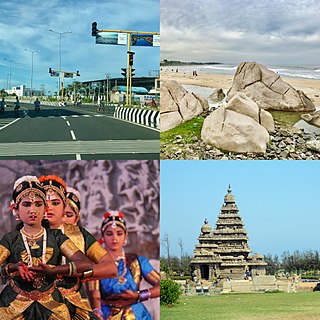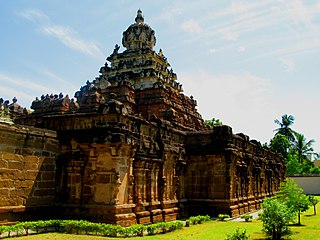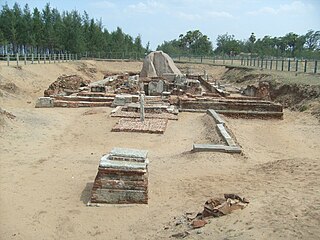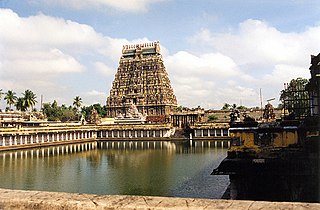Related Research Articles

Mamallapuram, is a town in Chengalpattu district in the southeastern Indian state of Tamil Nadu, best known for the UNESCO World Heritage Site of 7th- and 8th-century Hindu Group of Monuments at Mahabalipuram. It is one of the famous tourist sites in India. The ancient name of the place is Thirukadalmallai. It is a part of Chennai Metropolitan Area. It is a satellite town of Chennai.

The Pandya dynasty, also referred to as the Pandyas of Madurai, was an ancient Tamil dynasty of South India, and among the four great kingdoms of Tamilakam, the other three being the Pallavas, the Cholas and the Cheras. Existing since at least the 4th to 3rd centuries BCE, the dynasty passed through two periods of imperial dominance, the 6th to 10th centuries CE, and under the 'Later Pandyas'. Under Jatavarman Sundara Pandyan I and Maravarman Kulasekara Pandyan I, the Pandyas ruled extensive territories including regions of present-day South India and northern Sri Lanka through vassal states subject to Madurai. The Pandya dynasty is the longest ruling dynasty in the world.

The Pallava dynasty existed from 275 CE to 897 CE, ruling a significant portion of the Deccan, also known as Tondaimandalam. The Pallavas played a crucial role in shaping in particular southern Indian history and heritage. The dynasty rose to prominence after the downfall of the Satavahana Empire, whom they had formerly served as feudatories.

Nandi, also known as Nandikeshvara or Nandideva, is the bull vahana (mount) of the Hindu god Shiva. He is also the guardian deity of Kailash, the abode of Shiva. Almost all Shiva temples display stone images of a seated Nandi, generally facing the main shrine.

The Chera dynasty was a dynasty from early historic Tamil-speaking southern India, or the Sangam period, ruling over parts of present-day Kerala and Tamil Nadu states. The lineage, known as one of the Three Crowned Kings of Tamilakam alongside the Chola and Pandya, has been documented as early as c. 4th to 3rd centuries BCE. Their governance extended over diverse territories until the end of the early historic period in southern India.

The Kalabhra dynasty, also called Kaḷabrar, Kaḷappirar, Kallupura or Kalvar, were rulers of all or parts of Tamil region sometime between the 3rd century and 6th century CE, after the ancient dynasties of the early Cholas, the early Pandyas and Chera. Information about the origin and reign of the Kalabhras is uncertain and scarce. It is believed by historians that the Kalabhras belonged to the kaarkaathaar community of warriors who were possibly once the feudatories of the Cholas and the Pallavas. Their proposed roots vary from southeast region of modern Karnataka, Kalappalars of Kaarkaathaar community, to Kallar chieftains. This age is generally called "The Augustan age of Tamil Literature", in a 1922 book by the name "Studies in South Indian Jainism" written by M. S. Ramaswami Ayyangar and B. Seshagiri Rao. The Kalabhra era is sometimes referred to as the "dark period" of Tamil history, and information about it is generally inferred from any mentions in the literature and inscriptions that are dated many centuries after their era ended.

Tenavaram temple is a historic Hindu temple complex situated in the port town Tenavaram, Tevanthurai, Matara) near Galle, Southern Province, Sri Lanka. Its primary deity was a Hindu god Tenavarai Nayanar (Upulvan) and at its zenith was one of the most celebrated Hindu temple complexes of the island, containing eight major kovil shrines to a thousand deity statues of stone and bronze and two major shrines to Vishnu and Shiva. Administration and maintenance was conducted by residing Hindu Tamil merchants during Tenavaram's time as a popular pilgrimage destination and famed emporium employing over five hundred devadasis.

Tamil-Brahmi, also known as Tamili or Damili, was a variant of the Brahmi script in southern India. It was used to write inscriptions in Old Tamil. The Tamil-Brahmi script has been paleographically and stratigraphically dated between the third century BCE and the first century CE, and it constitutes the earliest known writing system evidenced in many parts of Tamil Nadu, Kerala, Andhra Pradesh and Sri Lanka. Tamil Brahmi inscriptions have been found on cave entrances, stone beds, potsherds, jar burials, coins, seals, and rings.
Most of the pre-modern coinage used in Sri Lanka or coins used in pre-Christian Sri Lanka can be categorised as punch-marked coins, tree and swastika coins, elephant and swastika coins and Lakshmi plaques.

The earliest deciphered epigraphy found in the Indian subcontinent are the Edicts of Ashoka of the 3rd century BCE, in the Brahmi script.

There are literary, archaeological, epigraphic and numismatic sources of ancient Tamil history. The foremost among these sources is the Sangam literature, generally dated to 5th century BCE to 3rd century CE. The poems in Sangam literature contain vivid descriptions of the different aspects of life and society in Tamilakam during this age; scholars agree that, for the most part, these are reliable accounts. Greek and Roman literature, around the dawn of the Christian era, give details of the maritime trade between Tamilakam and the Roman empire, including the names and locations of many ports on both coasts of the Tamil country.

Thiru Parameswara Vinnagaram or Vaikunta Perumal Temple is a Hindu temple dedicated to the God Vishnu, located in Kanchipuram in the Southern Indian state of Tamil Nadu. Constructed in the Dravidian style of architecture, the temple is glorified in the Nalayira Divya Prabandham, the early medieval Tamil canon of the Alvar saints from the 6th through the 9th centuries CE. It is one among the 108 Divya Desams dedicated to the God Vishnu, who is worshipped as Vaikuntanathan and his consort, the Goddess Lakshmi as Sri Vaikundavalli. The temple is considered the second oldest extant temple in Kanchipuram after the Kailasanathar temple.

Buddhism amongst the Tamils was historically found in the Tamilakam region of India and Sri Lanka.

Nandināgarī is a Brahmic script derived from the Nāgarī script which appeared in the 7th century AD. This script and its variants were used in the central Deccan region and south India, and an abundance of Sanskrit manuscripts in Nandināgarī have been discovered but remain untransliterated. Some of the discovered manuscripts of Madhvacharya of the Dvaita Vedanta school of Hinduism are in Nandināgarī script.

The Murugan Temple at Saluvankuppam, Tamil Nadu, India, is a shrine dedicated to Tamil Hindu deity Murugan. Archaeologists believe that the shrine, unearthed in 2005, consists of two layers: a brick temple constructed during the Sangam period and a granite Pallava temple dating from the 8th century CE and constructed on top of the brick shrine making it the oldest temple in India. The Archaeological Survey of India (ASI) team which conducted the excavation believe that brick temple could be the oldest of its kind to be discovered in Tamil Nadu.

Iconography of Shiva temples in Tamil Nadu is governed by the Shaiva Agamas (IAST:Āgama) that revere the ultimate reality as the Hindu deity, Shiva. Āgama in the Hindu religious context means a traditional doctrine or system which commands faith. Temple worship according to Āgamic rules can be said to have started during the Pallava dynasty in South India, but they were fully under establishment during the Chola dynasty The temples during the Chola period expanded to Sri Lanka and islands in South East Asia. The temple complex was expanding with niches for various deities on the stipulated sides of the sanctum. Lingam was universalised and prakarams (precincts) with subsequent deities came up. The temple parivara expanded considerably during the Chola period. The niches of following Āgamic rules for building Shiva temples in Tamil Nadu, a South Indian state continues even in the modern era. Some of the prime images like that of lingam, Vinayagar and Parvati are present in all the Shiva temples. Almost all the temples follow the same custom during festivals and worship methods with minor exceptions. Most of the Shiva temples in Tamil Nadu and Sri Lanka are built in Dravidian architecture.

The Flag of Pandya was used by the Pandyan Dynasty and consisted of the single fish or twin fish. There is no reference or description about the flag. Therefore, any Pandya flags used in media are created for the purpose of illustration. There are flags with double fish or single fish as per archaeological findings and historians's illustration.
The Flag of Pallava was used by the Tamil Pallava Kingdom. The Pallava royal insignia was the Simha (Lion) and Nandi (Bull) which was changeable. But the Color of the flag is saffron or yellow. Each Pallava king had his own personal banner. For example, Narasimhavarman II used the lion as his emblem and Nandivarman II preferred the Nandi. Under the reign of Paramesvaravarman I was Khatvanga added to the Pallava emblem. There were probably different Pallava lines, The main line ruled in Kanchipuram and comes from the Simha line. The Simha emblem was inherited from descendants of the Simha line.

The Pandyan empire is believed to have first emerged circa 600 BC and was one of the leading Tamil dynasties of Southern India. There were various forms of art and many architectural communities within the empire, and their work was sold to overseas markets. Rock cutting and structural temples are examples of these, playing a significant role in Pandyan culture. The rock carvings typically depicted religious figures, floral motifs and animals and were made to surround temples and shrines.
Penneshvarar Temple, also known as Penneshvaramadam Shiva Temple, is a Hindu temple of Shiva in the Krishnagiri district in Tamilnadu. It was built by Kulothunga Chola III in the year 1188 CE in the 12th Century CE, after defeating the Hoysala dynasty of present day Karnataka region. It is located in Penneshvaramadam, Kaveripattinam Town near Talihalli, Krishnagiri District. The temple is straight next to Thenpennai River which flows from Nandi Hills. This Temple exists as the origin for Bharadvaja Gotra, an ethnic group of Brahmanas in Tamil Nadu who are royal descendants of later Pallavas had capital as present day Kanchipuram on Palar River in Tamilnadu. They got migrated to western part of Tamilnadu and towards some parts of Karnataka. The Temple has the highest number of sculptures of Navakandam within the state of Tamil Nadu.
References
- ↑ Society, American Oriental (1913). Journal of the American Oriental Society. American Oriental Society. p. 213.
- ↑ The Gazetteer of India: History and culture. Publications Division, Ministry of Information and Broadcasting. 1965. pp. xxxviii.